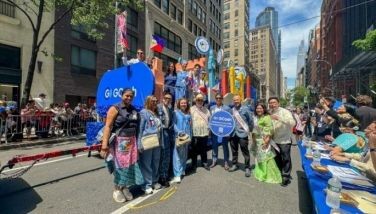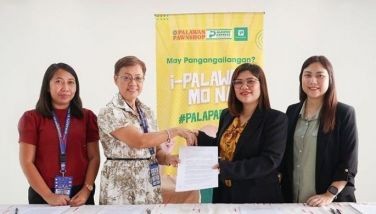119 Philippine banks join microfinance bandwagon
June 17, 2003 | 12:00am
The Bangko Sentral ng Pilipinas (BSP) reported yesterday substantial progress in the efforts to extend the reach of microfinance operations to the "poorest of the entrepreneurial poor" nationwide.
BSP Deputy Governor Alberto V. Reyes, chairman of the BSP microfinance committee, said that as of May 2003, there were 119 banks with 363 branches that were engaged in microfinance reaching 394,613 borrowers with total loans outstanding of P2.2 billion.
In his 2002 progress report, Reyes said 11 banks with 22 branches started microfinance operations in 11 provinces not previously covered by any bank with microfinance operations.
The Philippine central bank granted rediscounting facilities to 10 banks, meaning increasing their lending capability, with total loans outstanding amounting to P21.7 billion involving 9,623 micro-borrowers.
The BSP is mandated by Republic Act (RA) 8791 otherwise known as the General Banking Law, to provide the policy and regulatory framework to encourage the growth of microfinance activities.
It has adopted microfinance as its advocacy program to help the alleviation of poverty and has designated Monetary Board (MB) member Antonino L. Alindogan Jr. as the lead advocate and promoter of microfinance.
The BSP defines microfinance as "the provision of a broad range of financial services, but mainly lending without collateral to the poor to enable them to go into small businesses, hence entrepreneurial poor or "e-poor". The loans can be as low as P2,000 but not more than P150,000.
Since 2001, the BSP had issued four circulars and subsequent amendments to encourage the establishment of microfinance institutions and persuade banks to go into microfinance. The objective is to provide facilities to all microfinance borrowers in all provinces.
In her first State of the Nation Address (SONA) in 2001, President Gloria Macapagal-Arroyo expressed the desire to see at least 300,000 new microfinance borrowers every year.
Reyes said that as part of its advocacy effort, the BSP met with foundations and big corporations to explore ways for them to invest money in microfinance. So far, it has also conducted three regional seminars in La Union, Cebu and Iloilo with a total of 455 participants to also encourage potential microfinance practitioners.
Monetary authorities however said that the biggest challenge remains in a somewhat fragmented microfinance sector under a situation where the strongest proponent of micro-lending is not regulated by government.
The non-government organizations (NGOs) are the main proponent of the sector.
The sector is basically self-regulating without any state guidance or intervention. These situations resulted in generally positive results from well-meaning NGOs. However, they only comprise a fifth of the estimated number of the total NGOs involved in microfinance.
There are two general types of microfinance institutions (MFIs) involved in the extension microcredit. These are the formal and the informal sector. The formal sector is basically the banking sector including the commercial, thrift and savings, rural and cooperative banks, and lately the microfinance-oriented banks. There are also the lending investors and pawnshops. The informal sector is comprised of the NGOs, cooperatives and credit unions.
The formal banking sector is regulated by the BSP while the lending investors and the pawnshops are under the supervision of the SEC.
BSP Deputy Governor Alberto V. Reyes, chairman of the BSP microfinance committee, said that as of May 2003, there were 119 banks with 363 branches that were engaged in microfinance reaching 394,613 borrowers with total loans outstanding of P2.2 billion.
In his 2002 progress report, Reyes said 11 banks with 22 branches started microfinance operations in 11 provinces not previously covered by any bank with microfinance operations.
The Philippine central bank granted rediscounting facilities to 10 banks, meaning increasing their lending capability, with total loans outstanding amounting to P21.7 billion involving 9,623 micro-borrowers.
The BSP is mandated by Republic Act (RA) 8791 otherwise known as the General Banking Law, to provide the policy and regulatory framework to encourage the growth of microfinance activities.
It has adopted microfinance as its advocacy program to help the alleviation of poverty and has designated Monetary Board (MB) member Antonino L. Alindogan Jr. as the lead advocate and promoter of microfinance.
The BSP defines microfinance as "the provision of a broad range of financial services, but mainly lending without collateral to the poor to enable them to go into small businesses, hence entrepreneurial poor or "e-poor". The loans can be as low as P2,000 but not more than P150,000.
Since 2001, the BSP had issued four circulars and subsequent amendments to encourage the establishment of microfinance institutions and persuade banks to go into microfinance. The objective is to provide facilities to all microfinance borrowers in all provinces.
In her first State of the Nation Address (SONA) in 2001, President Gloria Macapagal-Arroyo expressed the desire to see at least 300,000 new microfinance borrowers every year.
Reyes said that as part of its advocacy effort, the BSP met with foundations and big corporations to explore ways for them to invest money in microfinance. So far, it has also conducted three regional seminars in La Union, Cebu and Iloilo with a total of 455 participants to also encourage potential microfinance practitioners.
Monetary authorities however said that the biggest challenge remains in a somewhat fragmented microfinance sector under a situation where the strongest proponent of micro-lending is not regulated by government.
The non-government organizations (NGOs) are the main proponent of the sector.
The sector is basically self-regulating without any state guidance or intervention. These situations resulted in generally positive results from well-meaning NGOs. However, they only comprise a fifth of the estimated number of the total NGOs involved in microfinance.
There are two general types of microfinance institutions (MFIs) involved in the extension microcredit. These are the formal and the informal sector. The formal sector is basically the banking sector including the commercial, thrift and savings, rural and cooperative banks, and lately the microfinance-oriented banks. There are also the lending investors and pawnshops. The informal sector is comprised of the NGOs, cooperatives and credit unions.
The formal banking sector is regulated by the BSP while the lending investors and the pawnshops are under the supervision of the SEC.
BrandSpace Articles
<
>
- Latest
Latest
Latest
September 11, 2024 - 2:00pm
September 11, 2024 - 2:00pm
June 28, 2024 - 2:55pm
June 28, 2024 - 2:55pm
Recommended






























